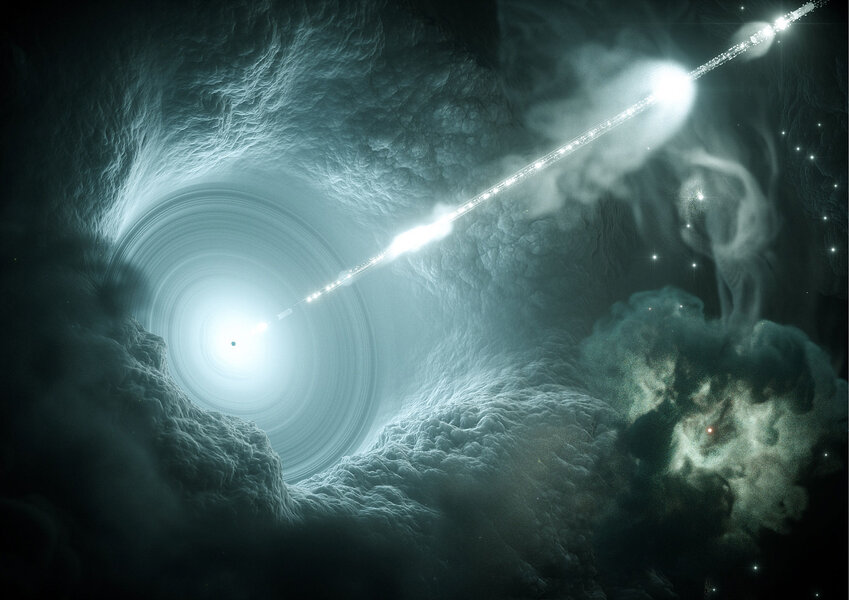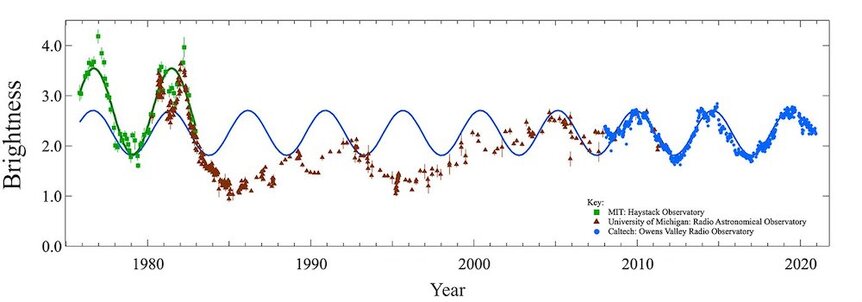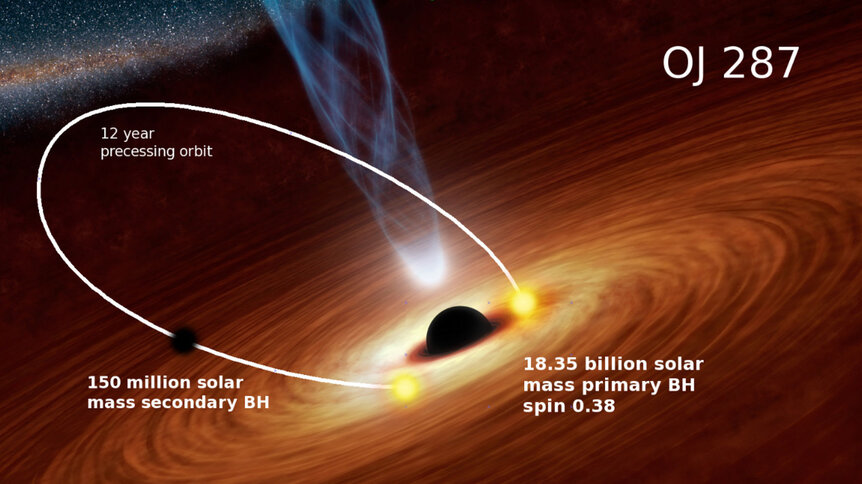Create a free profile to get unlimited access to exclusive videos, sweepstakes, and more!
This pair of supermassive black holes may be doomed to collide in 10,000 years
The tightest pair of monster black holes ever seen are 9 billion light years away.

Astronomers have found what looks very much like a pair of supermassive black holes that are orbiting each other in a binary pair. This is a rare beast, but what makes this even more amazing is that, if they're right, these two monsters are doomed to spiral together and merge in as little as ten thousand years!
If this is the case, these black holes are the tightest pair like them ever seen, and will merge far sooner than any other known system.
We know that essentially every big galaxy has a supermassive black hole at its heart, weighing in at millions to billions of times the mass of the Sun. Sometimes they're not feeding, so they're quiescent — Sgr A*, the black hole in the center of our Milky Way, is napping at the current time. But some have huge amounts of gas and dust falling into them. This material forms a disk that can be many light years across, and the matter in it gets so hot it can glow fiercely, outshining all the stars in the galaxy combined.
This motion, coupled with intense magnetic fields (and sometimes the spin of the black hole) can cause the formation of two exceedingly powerful beams of matter and energy that blast away, up and down from the disk. These are called jets, and are so energetic that emit light across the entire electromagnetic spectrum. If one of the jets is aimed right at us, or very nearly so, we see super-high-energy gamma rays from it, and we call that galaxy a blazar.
Blazars are feisty, and can erupt in huge flares, or show quiet periods that can last for a long time. This mostly depends on how smoothly matter flows into them; a sharp increase in material can cause a huge flare. However, we think that a lot of these supermassive black holes should be in binary systems, orbiting a second black hole; this can happen when two galaxies collide and their black holes fall toward each other.
So astronomers monitor blazars with radio telescopes, examining their light to see if they can find any changes in brightness or behavior that could indicate a second black hole lurking there.
PKS 2131-021 is just such a blazar. It's located a staggering 9 billion light years from Earth, and is part of a list of thousands of blazars routinely monitored. It stuck out from the sample due to what looks like a periodic variation in its brightness, brightening and dimming on a smooth sine-wave-like 4.7-year cycle. But the survey has only been going on for a little more than a decade, so it's hard to say if that period was real or not.
A team of astronomers started digging through old observations, though, and hit paydirt (link to paper). They found observations made at different radio observatories covering a range of times going all the way back to 1975. Over this 45+-year range they made an astonishing discovery: tracing the cycle seen in more recent data backwards in time, they found the variations seen decades ago match the period of the variations almost exactly!
That's pretty weird, given how chaotic blazars are. But the astronomers have a rather simple explanation: As the two black holes orbit each other, the one that's blasting out jets is sometimes moving away from us, and sometimes toward us. When it moves toward us the jet gets brighter due to an effect called relativistic beaming, which I've written about before:
There's an effect called relativistic beaming [...] If you hold a light bulb in front of you, the light expands in a sphere, in all directions, But if that light bulb is moving near the speed of light, the light we see emitted from it appears to be beamed, like a flashlight, aimed into the direction it's moving. This bizarre effect means that an object headed toward you at close to the speed of light appears brighter, because more of its light is focused toward you, and something moving away appears darker, because its light is focused away from you.
If the astronomers are correct, and the brightness variation seen in PKS 2131-021 is due to this effect, it means the two orbit each other every 2.1 years — we see that as 4.7 years because the Universe is expanding, and at the tremendous distance of 9 billion light years, the blazar is moving away from us rapidly enough that time dilation lengthens the apparent period.
They can't measure the black hole masses directly, but if they are at the higher end of the scale (over 100 million times the Sun's mass) then they'd be about 0.3 light years apart. However, if they're lower mass they'd be much closer together, as little as 0.03 light years: 300 billion kilometers, only about 70 times the distance of Neptune from the Sun.
For supermassive black holes, that's close. The nearest contender to that is the blazar OJ 287, and those black holes are likely ten times farther apart.
Black holes as close as these two appear to be are doomed. Another prediction of relativity, now confirmed, is that they will literally create ripples in the fabric of spacetime called gravitational waves. This steals orbital energy away, so the two black holes drop closer together over time. The strength of the waves goes up as the distance between the two drops, so this is a runaway effect. It could mean the two will merge in as little as 10,000 years, blasting out gravitational waves that will be detectable across the Universe.
Mind you, a merger like this usually takes hundreds of millions if not billions of years, so they're really at the very tail end of this process.
To be clear, I'll note that the brightness variations in PKS 2131-021 could be due to other effects. Sometimes the black hole jet wobbles, changes direction over time, and this too could cause the variation. But the astronomers feel that the orbital motion explanation is simpler, citing Occam's Razor, and is more likely to be true. That's fine, and certainly an acceptable model to use until further data supports or undermines it. But it's good to keep in mind it might be due to something else.
But if they're right this could be an exemplar of binary black holes to study. Very few such binary supermassive black holes are known, and if it's possible to find them by looking for variability in this manner it's possible more could be waiting for us to discover them. That would be a huge boon to astronomers, so, while I keep room for doubt, I'm hoping this blazar does indeed turn out to be one of these rare cases.





























